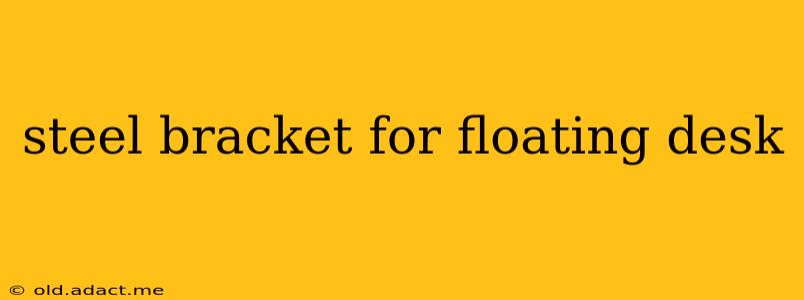Floating desks offer a sleek, modern aesthetic and can save valuable floor space. But the secret to a successful floating desk lies in the unseen—the robust support system, often provided by steel brackets. Choosing the right steel bracket is crucial for both safety and aesthetics. This guide explores everything you need to know about selecting and installing steel brackets for your floating desk.
What to Consider When Choosing Steel Brackets for Your Floating Desk
Several factors influence the type of steel bracket you'll need. Ignoring these can lead to instability, damage, and even injury. Let's dive into the key considerations:
1. Desk Weight and Dimensions:
This is paramount. Heavier desks require stronger, more substantial brackets. Larger desks demand more brackets for even weight distribution. Always check the bracket's weight capacity before purchasing. Don't underestimate the weight; include the weight of the desk itself, plus anything you plan to place on it (computer, monitors, books, etc.).
2. Wall Material:
The type of wall material significantly impacts bracket selection. Different brackets are designed for different materials:
- Stud Walls: These are the most common type of wall in many homes and offer the strongest support. Brackets designed for stud walls typically use screws to fasten directly into the studs.
- Drywall Walls: Drywall alone is not strong enough to support a floating desk. Specialized drywall anchors or toggle bolts are necessary to distribute the weight effectively across a larger area.
- Concrete or Brick Walls: These require specialized heavy-duty brackets and appropriate fasteners. Concrete screws or expansion anchors are usually necessary.
3. Bracket Style and Design:
Steel brackets come in various styles, including L-brackets, Z-brackets, and more specialized designs. Consider:
- Aesthetics: Do you want visible brackets or a more minimalist look? Some brackets are designed to be concealed or less prominent.
- Strength and Durability: Look for brackets made from high-quality steel with a robust design. Check for features like reinforced corners and thicker gauge steel.
- Adjustability: Some brackets allow for adjustable height or depth, which can be helpful for fine-tuning the desk's position.
4. Installation Difficulty:
Some brackets are easier to install than others. Consider your DIY skills and comfort level. If you're unsure, seek professional help.
How Much Weight Can a Steel Bracket Hold?
The weight capacity varies dramatically depending on the bracket's design, material, and installation. Never exceed the manufacturer's stated weight capacity. Check the product specifications carefully before purchasing. A seemingly small difference in weight can have significant consequences.
What Kind of Anchors Do I Need for a Floating Desk?
The type of anchor depends heavily on your wall material:
- Stud Walls: Heavy-duty wood screws are usually sufficient.
- Drywall Walls: Use drywall anchors rated for the desk's weight, or better yet, toggle bolts for superior holding power.
- Concrete or Brick Walls: Concrete screws or expansion anchors are necessary.
How Do I Install Steel Brackets for a Floating Desk?
Installing steel brackets can be a DIY project, but it’s crucial to follow the manufacturer’s instructions carefully. Accurate measurements and proper fastening are key to ensure stability and safety. If you're not confident in your DIY skills, hire a professional.
Choosing the Right Size Steel Bracket for Your Desk
The appropriate size depends entirely on your desk's dimensions and weight. There's no one-size-fits-all answer. Always measure your desk carefully and consult the bracket manufacturer's specifications to ensure you select brackets with sufficient load-bearing capacity.
Conclusion
Selecting the right steel brackets for your floating desk is a crucial step in ensuring safety, stability, and a successful installation. By carefully considering the factors discussed above, you can create a stunning and functional floating desk that will last for years. Remember: always prioritize safety and consult a professional if you have any doubts about the installation process.
